| Pros of October Glory Maple Tree | Cons of October Glory Maple Tree |
|---|---|
| 1. Vibrant fall foliage: Attractive range of colors during autumn. | 1. Large size: Unsuitable for small yards. |
| 2. Fast growth rate: Quick establishment for shade. | 2. Shallow root system: Susceptible to wind damage. |
| 3. Tolerance for various soil conditions: Versatile planting locations. | 3. Susceptible to sunscald: Bark damage in full sun. |
| 4. Resistance to pests and diseases: Low-maintenance tree. | 4. Vulnerability to deer browsing: Potential damage to leaves and branches. |
| 5. Provides ample shade: Creates a comfortable outdoor space. | 5. May produce suckers: Competition with the parent tree. |
October Glory Maple Tree Overview
The Acer rubrum ‘October Glory’ is a deciduous tree known for its spectacular fall foliage, making it a sought-after choice for landscaping. This tree can reach impressive dimensions, standing up to 40 feet tall and spreading out to 35 feet wide. Its growth characteristics make it a fast-growing species, achieving a height of 20 feet in just a decade. The deciduous nature of the tree means that it undergoes seasonal changes, with dark green leaves in the spring and summer, transforming into a fiery red display in the fall. These features make the October Glory Maple an appealing addition to any outdoor space, not only for its aesthetic value but also for its ability to provide ample shade.
Growth Characteristics
Understanding the growth characteristics of the October Glory Maple is crucial for those considering it for their landscapes. This tree can reach a substantial height of 40 feet, creating a majestic presence in the outdoor environment. Its width of 35 feet contributes to a broad canopy that offers generous shade. The deciduous nature of the tree means that it sheds its leaves annually, undergoing a cyclical process of growth, dormancy, and renewal. Homeowners should take these dimensions into account when planning the placement of the October Glory Maple in their yards to ensure it aligns with the available space.
Seasonal Changes in Foliage
One of the standout features of the October Glory Maple is its captivating transformation during different seasons. In spring and summer, the tree boasts dark green leaves, contributing to a lush and vibrant appearance. As autumn approaches, the foliage undergoes a dramatic change, transitioning to hues of red, orange, and yellow. This seasonal display adds a dynamic element to the landscape, creating a visually stunning scene. Homeowners looking to infuse their outdoor spaces with a burst of color can benefit from the vibrant fall foliage of the October Glory Maple.
Pros of October Glory Maple Tree
The October Glory Maple tree comes with a host of advantages that make it a popular choice among homeowners and landscapers alike. Understanding these pros can help individuals assess whether this tree aligns with their landscaping goals.
Pro: Vibrant Fall Foliage
The standout feature of the October Glory Maple is undoubtedly its vibrant fall foliage. The tree undergoes a breathtaking transformation, displaying a spectrum of colors ranging from deep red to bright orange and yellow. This characteristic makes it a top pick for individuals seeking to add a visual spectacle to their landscapes during the autumn months.
Attractive Range of Colors
The October Glory Maple’s fall foliage isn’t limited to a single shade but encompasses a diverse range of colors. This diversity adds depth and dimension to the tree’s appearance, creating a picturesque scene in residential yards and public spaces alike. The ability to offer such a vibrant display is a significant factor in the tree’s popularity among homeowners.
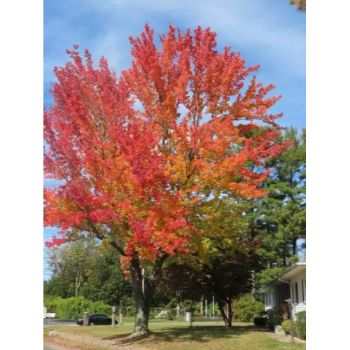
Pro: Fast Growth Rate
For those looking to establish a shade tree quickly, the October Glory Maple’s fast growth rate is a significant advantage. Within a span of 10 years, this tree can reach a height of up to 20 feet, making it an ideal choice for individuals who want to enjoy the benefits of a mature shade tree in a relatively short period.
Quick Establishment for Shade
The rapid growth of the October Glory Maple means that homeowners can experience the benefits of shade sooner rather than later. This is particularly advantageous for those living in regions with warm climates, where the presence of shade contributes to a more comfortable outdoor environment.
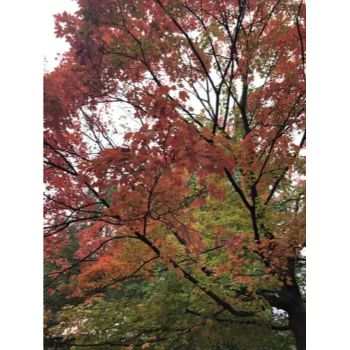
Pro: Tolerance for Various Soil Conditions
The versatility of the October Glory Maple extends to its tolerance for a variety of soil conditions. Whether the soil in a particular location is clay, loam, or sand, this tree can adapt and thrive. This adaptability makes it a versatile choice for different landscaping scenarios.
Versatility in Planting Locations
Homeowners often face challenges related to soil types in their yards. The October Glory Maple’s ability to thrive in various soil conditions provides flexibility in choosing planting locations. Whether it’s a clay-heavy soil or a sandy terrain, this tree can flourish, offering a solution for diverse landscaping needs.
Pro: Resistance to Pests and Diseases
The low-maintenance nature of the October Glory Maple is further emphasized by its resistance to pests and diseases. While no tree is entirely immune to potential threats, this cultivar exhibits a notable level of resilience. This resistance minimizes the need for extensive pest control measures, making it an attractive option for those seeking a hassle-free addition to their landscapes.
Low-Maintenance Tree
Homeowners often appreciate low-maintenance landscaping options, and the October Glory Maple fits the bill. With its resistance to common pests and diseases, this tree requires less intervention and care, allowing individuals to enjoy its beauty without the burden of constant maintenance.
Pro: Provides Ample Shade
Beyond its aesthetic appeal, the October Glory Maple is valued for its ability to provide substantial shade. The large dimensions of this tree contribute to the creation of a shaded area in outdoor spaces, offering relief from the sun’s intensity. This shading effect can lead to reduced energy costs for homeowners and a more comfortable outdoor experience.
Creating a Comfortable Outdoor Space
The generous shade provided by the October Glory Maple makes it an excellent choice for those looking to enhance the usability of their outdoor spaces. Whether it’s for hosting gatherings, relaxing in the yard, or simply enjoying the natural surroundings, the shaded area created by this tree contributes to a more comfortable outdoor living experience.
Cons of October Glory Maple Tree
While the October Glory Maple comes with numerous benefits, it’s essential to consider the potential drawbacks before deciding to incorporate it into a landscape. Being aware of these cons allows homeowners to make informed decisions based on their specific needs and constraints.
Con: Large Size
The impressive size of the October Glory Maple, while advantageous for shade provision, can be a drawback for those with limited yard space. Understanding the potential challenges associated with its size is crucial for homeowners considering this tree for their landscapes.
Not Suitable for Small Yards
Individuals with small yards may find the size of the October Glory Maple overwhelming. The extensive spread of branches and foliage requires ample space to accommodate the tree without crowding the surrounding area. Homeowners with limited outdoor space should carefully assess whether the size aligns with their landscaping goals.
Con: Shallow Root System
The October Glory Maple’s shallow root system is a characteristic that warrants consideration, as it can have implications for both the tree itself and the surrounding landscape. Understanding the challenges associated with a shallow root system is essential for successful tree management.
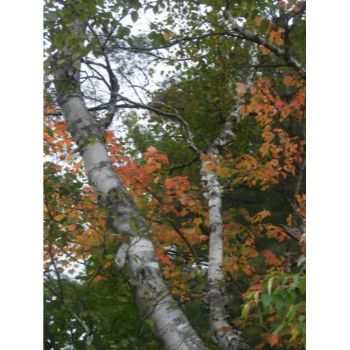
Susceptibility to Wind Damage
Trees with shallow root systems are more susceptible to wind damage, and the October Glory Maple is no exception. In regions prone to strong winds or storms, the tree’s stability may be compromised. Implementing measures to mitigate the risk of wind damage is crucial for the tree’s overall health and longevity.
Potential for Damage to Structures
The shallow roots of the October Glory Maple can extend quite far from the trunk, posing a risk of damage to nearby structures. Sidewalks, driveways, and even septic tanks may be at risk of root intrusion. Homeowners need to carefully plan the placement of this tree to avoid potential conflicts with existing structures.
Con: Susceptibility to Sunscald
Sunscald, a condition that can damage the bark of trees, is a potential concern for the October Glory Maple, particularly when planted in full sun conditions. Understanding the factors contributing to sunscald and implementing preventive measures is crucial for maintaining the tree’s health.
Bark Damage in Full Sun Conditions
Trees planted in areas with prolonged exposure to full sun may experience bark damage due to sunscald. This can affect the overall health and appearance of the tree. Homeowners should assess the sunlight conditions in their yards and consider partial shading for the October Glory Maple to mitigate the risk of sunscald.
Con: Vulnerability to Deer Browsing
For those living in areas with a significant deer population, the vulnerability of the October Glory Maple to deer browsing is a relevant consideration. Understanding the potential impact of deer on the tree’s leaves and branches is essential for maintaining its aesthetic appeal.
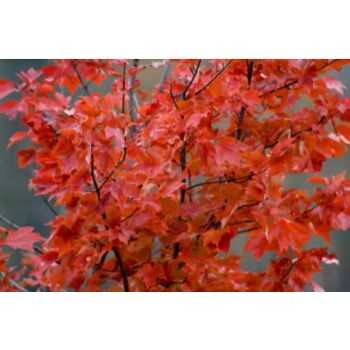
Potential Damage to Leaves and Branches
Deer browsing can lead to damage to the leaves and branches of the October Glory Maple. This not only affects the tree’s visual appeal but may also impact its overall health. Implementing deer deterrent measures can be crucial for protecting the tree from browsing-related damage.
Con: Sucker Production
The production of suckers, young trees that grow from the roots of the parent tree, is a potential concern associated with the October Glory Maple. Managing the growth of suckers is important to prevent competition for water and nutrients, ensuring the health of the parent tree.
Competition with Parent Tree
Suckers growing from the roots of the October Glory Maple can be unsightly and may compete with the parent tree for essential resources. Homeowners should be proactive in managing sucker growth to maintain the overall health and vitality of the tree.
Overall Assessment
Assessing the overall suitability of the October Glory Maple involves weighing the pros and cons to determine whether it aligns with the specific needs and constraints of a given landscape. While the tree offers vibrant fall foliage, fast growth, and versatility in soil conditions, its large size, shallow root system, and susceptibility to certain issues require careful consideration.
Suitable Landscapes for October Glory Maple
The October Glory Maple is best suited for larger yards and landscapes where its impressive size can be accommodated without causing crowding issues. Homeowners with expansive outdoor spaces can fully capitalize on the tree’s aesthetic and functional benefits.
Considerations Before Planting
Before planting the October Glory Maple, individuals should carefully assess their yard’s size, soil conditions, and susceptibility to potential issues like wind damage and deer browsing. Planning the placement of the tree strategically can maximize its positive attributes while mitigating potential drawbacks.
Balance Between Pros and Cons
Achieving a balanced perspective on the pros and cons of the October Glory Maple is crucial for making an informed decision. Homeowners should prioritize aspects that align with their landscaping goals while addressing potential challenges through thoughtful planning and proactive tree management.
Where to Buy and Planting Guidelines
Acquiring a healthy October Glory Maple tree and planting it with care are essential steps for ensuring its successful integration into a landscape. Knowing where to purchase the tree and following proper planting guidelines contribute to its long-term health and vitality.
Purchase Options
Nurseries and Garden Centers
Reputable nurseries and garden centers are reliable sources for acquiring healthy October Glory Maple trees. Visiting these establishments allows individuals to personally inspect the trees and seek guidance from knowledgeable staff regarding the selection and care of the tree.
Online Retailers
For those who prefer the convenience of online shopping, reputable retailers such as Amazon and Home Depot offer October Glory Maple trees for purchase. When buying online, it’s crucial to choose a trusted seller that provides healthy trees of the appropriate size for the intended planting location.
Planting and Care Instructions
Planting and caring for an October Glory Maple tree involve a series of considerations to ensure its successful establishment and long-term health.
Soil Preferences
The October Glory Maple prefers well-drained soil, emphasizing the importance of selecting a planting location with suitable soil conditions. While the tree is tolerant of various soil types, ensuring proper drainage is essential for preventing waterlogged conditions that can adversely affect root health.
Sun and Shade Tolerance
While the October Glory Maple thrives in full sun conditions, it also exhibits tolerance for partial shade. Homeowners should consider the sunlight conditions in their yards and choose a planting location that aligns with the tree’s preferences for optimal growth.
Watering and Fertilization Tips
Proper watering is crucial, especially during the tree’s initial year after planting. Adequate hydration supports root establishment and overall growth. Once the tree is established, watering frequency can be reduced to periods of dry weather. Additionally, fertilizing the tree in the spring with a balanced fertilizer promotes healthy foliage and sustained growth.
October Glory Maple Tree vs. Red Maple Tree
Distinguishing between the October Glory Maple and its parent tree, the red maple (Acer rubrum), provides valuable insights into their similarities and differences. While both trees share common characteristics, subtle distinctions set them apart.
Comparison with the Red Maple Tree (Acer rubrum)
The October Glory Maple is a cultivar of the red maple tree, and as such, they share fundamental characteristics. However, certain features differentiate the two, influencing considerations for landscape selection.
Differences in Appearance and Characteristics
Vibrancy of Fall Foliage
While both trees exhibit vibrant fall foliage, the October Glory Maple is known for a more intense and varied display of colors. Its reds, oranges, and yellows create a striking visual impact, setting it apart from the red maple.
Pest and Disease Resistance
The October Glory Maple boasts slightly higher resistance to pests and diseases compared to the red maple. This aspect can be a determining factor for homeowners seeking a low-maintenance tree with enhanced resilience.
Frequently Asked Questions
Addressing common questions about the October Glory Maple provides additional insights for individuals considering this tree for their landscapes. From its overall suitability to specific concerns about root invasiveness and lifespan, these FAQs offer valuable information.
Is October Glory Maple a Good Tree?
The October Glory Maple is indeed a good tree for certain landscaping scenarios. Its vibrant fall foliage, fast growth, and resistance to pests make it an attractive choice. However, its suitability depends on factors such as yard size and specific preferences.
Root Invasiveness of October Glory Maples
Addressing concerns about root invasiveness is essential for homeowners, as tree roots can impact nearby structures. While the October Glory Maple has a shallow root system, proactive measures and strategic planting can mitigate potential issues.
Disadvantages of Maple Trees
Understanding the disadvantages of maple trees, including the October Glory Maple, allows homeowners to make informed decisions. Issues such as large size, shallow roots, and vulnerability to certain conditions should be considered in the overall assessment.
Presence of Helicopters in October Glory Maples
Maple trees are known for their winged seeds, often referred to as helicopters. While the October Glory Maple does produce these seeds, their presence is typically manageable and does not pose significant concerns for homeowners.
Planting Distance from the House
Determining the appropriate planting distance from the house is crucial to avoid potential conflicts with structures. Guidelines for the October Glory Maple recommend strategic placement to prevent issues related to roots and canopy spread.
Beauty Comparison Among Maple Trees
When comparing the beauty of maple trees, individual preferences play a significant role. While the October Glory Maple is celebrated for its vibrant fall foliage, other maple varieties also showcase unique and appealing characteristics. The Autumn Blaze Maple, for instance, is renowned for its rapid growth and brilliant red autumn leaves. Beauty is subjective, and the choice between maple trees ultimately depends on the specific aesthetic preferences of homeowners and their landscaping goals.
Why is My October Glory Maple Not Turning Red?
The phenomenon of an October Glory Maple not turning red can be attributed to various factors. Understanding these factors is crucial for addressing the issue and promoting the desired fall coloration.
Seasonal Variation
Natural variations in weather patterns can impact the timing and intensity of fall foliage. Factors such as temperature, sunlight duration, and moisture levels play a role in determining when and how vividly the October Glory Maple displays its red hues.
Stress Factors
Stressors, such as inadequate water supply, soil imbalances, or pest infestations, can affect the tree’s ability to undergo a vibrant color change. Addressing these stress factors through proper care and maintenance can encourage the desired red pigmentation.
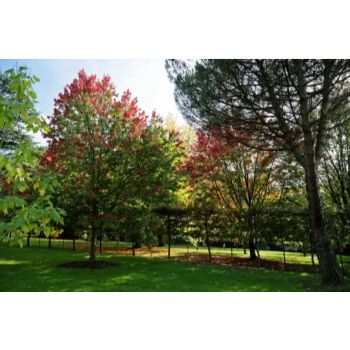
How Long Does an October Glory Maple Tree Live?
The lifespan of an October Glory Maple tree is influenced by various factors, including environmental conditions, care practices, and the overall health of the tree.
Environmental Factors
External factors such as climate, soil quality, and local weather conditions can impact the longevity of the tree. While the October Glory Maple is known for its resilience, providing an environment conducive to its preferences can contribute to a longer and healthier life.
Care Practices
Proper care, including regular watering, fertilization, and pruning, plays a vital role in extending the lifespan of the October Glory Maple. Addressing potential issues promptly and implementing a consistent care routine can contribute to the tree’s overall well-being.
What is the Hardiest Maple Tree?
The hardiness of maple trees varies, with different species exhibiting different levels of resilience to environmental conditions.
Acer saccharum (Sugar Maple)
The Sugar Maple is renowned for its hardiness and adaptability. It thrives in a variety of climates and soil types, making it a popular choice for homeowners seeking a robust and long-lived maple tree.
Acer platanoides (Norway Maple)
The Norway Maple is another hardy species known for its tolerance to urban conditions and resistance to pests and diseases. It withstands challenging environments, making it a suitable option for diverse landscapes.
What is the Difference Between Red Maple and October Glory Maple?
Distinguishing between the Red Maple and the October Glory Maple involves considering various characteristics that set them apart.
Fall Foliage Intensity
While both trees exhibit vibrant fall foliage, the October Glory Maple is known for a more intense and varied color display. Its red, orange, and yellow hues create a visually striking scene, distinguishing it from the Red Maple.
Pest and Disease Resistance
The October Glory Maple boasts slightly higher resistance to pests and diseases compared to the Red Maple. This factor contributes to its reputation as a low-maintenance tree with enhanced resilience.
Additional Considerations
Exploring additional considerations related to the October Glory Maple provides a comprehensive understanding for potential planters, addressing specific issues, and providing insights into regional variations.
Common Problems with October Glory Maple
Potential Pest Issues
While the October Glory Maple is generally resistant to pests, occasional pest issues may arise. Keeping an eye out for common pests such as aphids or scale insects and promptly addressing any infestations ensures the tree’s continued health.
Disease Susceptibility
Although the October Glory Maple is resistant to many diseases, certain environmental conditions may lead to issues such as leaf spot or tar spot diseases. Implementing preventive measures and promptly addressing any signs of disease can help maintain the tree’s vitality.
Comparison with Autumn Blaze Maple
Growth Rate
The Autumn Blaze Maple, known for its rapid growth, stands in contrast to the October Glory Maple. While both trees offer vibrant fall foliage, the Autumn Blaze Maple achieves a mature height more quickly, making it a preferred choice for those seeking fast results.
Fall Foliage Characteristics
While both trees boast attractive fall foliage, the October Glory Maple is distinguished by its more varied and intense color display. Homeowners looking for a diverse palette of reds, oranges, and yellows may find the October Glory Maple more appealing in this aspect.
October Glory Maple Tree Pros and Cons in Texas
Considerations specific to Texas highlight factors that individuals in this region should be mindful of when considering the October Glory Maple.
Climate Adaptability
The October Glory Maple’s tolerance for a variety of soil conditions extends to the diverse climates found in Texas. Its adaptability to different soil types and weather patterns makes it a suitable choice for landscaping in various regions of the state.
Watering Requirements
Given the climate variations in Texas, understanding the October Glory Maple’s watering needs is crucial. While the tree is relatively drought-tolerant once established, providing adequate water during dry periods ensures its continued health in the Texas climate.
October Glory Maple Lifespan
The lifespan of the October Glory Maple can vary based on environmental factors, care practices, and regional considerations.
Environmental Impact
Factors such as local climate conditions and soil quality influence the tree’s overall health and longevity. Creating an environment that aligns with the tree’s preferences contributes to a healthier and longer life.
Care Practices for Longevity
Implementing proper care practices, including regular watering, fertilization, and monitoring for potential issues, enhances the October Glory Maple’s lifespan. Proactive care measures play a pivotal role in ensuring the tree thrives over the years.
October Glory Maple Tree Growth Rate
The growth rate of the October Glory Maple is a key consideration for homeowners seeking a tree that establishes quickly.
Rapid Establishment
The October Glory Maple’s fast growth rate allows for relatively quick establishment, reaching a height of up to 20 feet in just a decade. This characteristic makes it an attractive option for those looking to enjoy the benefits of a mature shade tree in a shorter timeframe.
Sustained Growth
While the tree experiences rapid growth in its initial years, it continues to exhibit sustained growth throughout its life. This ongoing development contributes to the tree’s impressive size and overall majesty.
October Glory Maple Tree for Sale
Acquiring an October Glory Maple tree involves considering factors such as the source, size, and health of the tree.
Reputable Sellers
Choosing a reputable seller, whether from nurseries, garden centers, or online retailers, ensures that the tree is healthy and of high quality. Reviews and recommendations can guide individuals in selecting a trustworthy seller.
Appropriate Size for Yard
Selecting a tree of the correct size for the intended planting location is essential. Consider the available space in the yard and the tree’s potential dimensions to avoid issues related to crowding or inadequate space.
October Glory Maple Tree Size
Understanding the potential size of the October Glory Maple is crucial for planning its placement in a landscape.
Height and Width
With a maximum height of 40 feet and a width of 35 feet, the October Glory Maple’s substantial dimensions necessitate careful consideration of its placement. Homeowners should assess the available space to ensure the tree can thrive without causing crowding issues.
Canopy Spread
The expansive canopy spread of the October Glory Maple contributes to its ability to provide ample shade. However, homeowners should factor in the tree’s canopy dimensions when planning its placement to avoid conflicts with nearby structures.
October Glory Maple Tree Height
The height of the October Glory Maple is a defining characteristic that influences its visual impact and suitability for different landscapes.
Majestic Presence
With a maximum height of 40 feet, the October Glory Maple creates a majestic presence in outdoor spaces. This height contributes to the tree’s overall appeal, making it a standout feature in larger yards and landscapes.
Considerations for Yard Size
Individuals with smaller yards should carefully assess whether the tree’s height aligns with their landscaping goals. Planning for adequate spacing and accounting for the tree’s potential growth are essential considerations for optimal placement.
Conclusion
In conclusion, the October Glory Maple tree offers a combination of aesthetic appeal and functional benefits, making it a popular choice for landscaping. Its vibrant fall foliage, fast growth rate, and adaptability to various soil conditions make it an attractive option for homeowners seeking a visually striking and versatile tree. However, considerations such as its large size, shallow root system, and susceptibility to certain issues require careful planning and proactive care.
By weighing the pros and cons, homeowners can make informed decisions about whether the October Glory Maple aligns with their specific landscaping goals and constraints. Understanding where to purchase a healthy tree and following proper planting and care guidelines contribute to its successful integration into outdoor spaces.
While the October Glory Maple has its unique characteristics, comparisons with other maple trees, such as the Red Maple and Autumn Blaze Maple, provide valuable insights for individuals seeking alternatives that better suit their preferences. Additionally, addressing common questions, concerns, and considerations specific to regions like Texas enhances the overall understanding of the October Glory Maple and its role in different landscapes.
In the dynamic realm of landscaping, the October Glory Maple stands as a testament to the diverse and captivating beauty that trees bring to outdoor spaces. With careful consideration and proactive care, homeowners can enjoy the benefits of this majestic tree for years to come.
